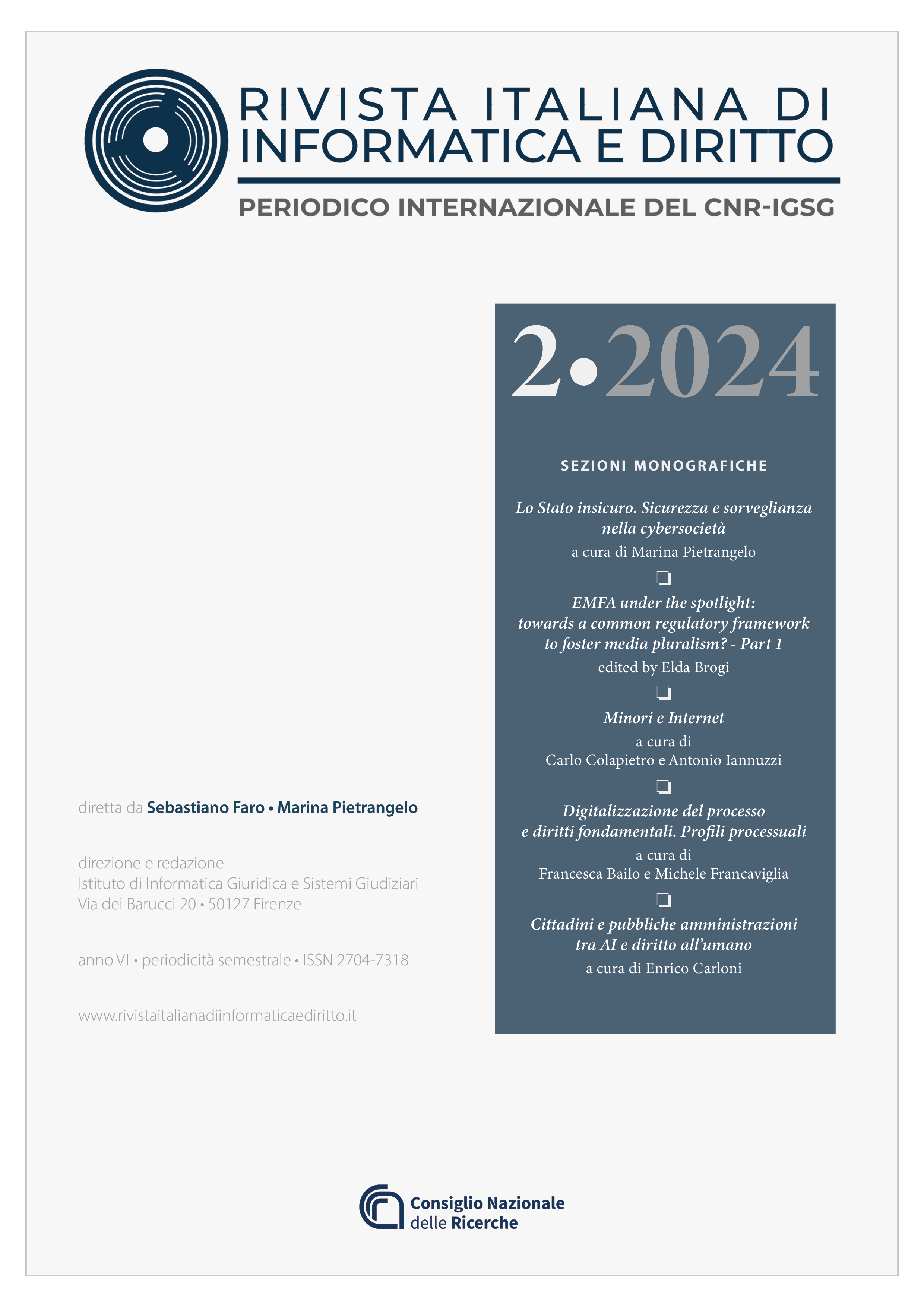What notion of pluralism in EMFA?
DOI:
https://doi.org/10.32091/RIID0180Keywords:
EMFA, Media pluralism, Public service media, Press, Disinformation, Algorithmic prioritisation of content, ProminenceAbstract
Through an analysis of the regulation (UE) 2024/1083, the article aims, on the one hand, to identify the concept of media pluralism that the European legislator has in mind in the EMFA (European Media Freedom Act) and, on the other hand, to identify the responses that the European legislator has made to the so-called new challenges of media pluralism. The answer to the first question is ‘open’, given the possibility of at least two different readings of the EMFA provisions: one, more reductive (and perhaps more realistic), according to which EMFA would be more like a (minimum) harmonisation directive than a regulation in these respects; another, less reductive, according to which the EU legislator would have identified – at least by default – internal pluralism as the form that should certainly be applied to public service media and external pluralism to non-public service media. With regard to the new challenges of pluralism, such as disinformation and the prioritisation of content, the EMFA’s answers seem to lie in guaranteeing the editorial independence and integrity of media service providers and in introducing adaptation rules or confirming the so-called prominence of general interest media services.
References
J. Barata (2024), Will the EMFA Improve Freedom of Expression, Media Pluralism, and Media Independence in Europe?, in “MediaLaws”, 2024
J. Barata (2022), Protecting Media Content on Social Media Platforms: The European Media Freedom Act’s Biased Approach, in “Verfassungsblog”, November 2022
L.C. Bollinger, G.R. Stone (eds.) (2019), The Free Speech Century, Oxford University Press, 2019
E. Boncinelli, A. Calvaruso (2021), Che cosa abbiamo nella testa?, il Saggiatore, 2021
E. Brogi, D. Borges, R. Carlini et al. (2023), The European Media Freedom Act: media freedom, freedom of expression and pluralism, Technical Report, European Parliament, 2023
M. Cartabia (2017), Convergenze e divergenze nell’interpretazione delle clausole finali della Carta dei diritti fondamentali dell’Unione europea, in “Rivista AIC”, 2017, n. 3
B. Charvin (2023), Good Bye, Putin! La guerre informationnelle a-t-elle sonné le glas du pluralisme? Réflexion sur l’arrêt du Tribunal de l’Union européenne relatif à la suspension de RT France (aff. n° T-125/22, 27 juillet 2022), in “La Revue des Droits de l’Homme”, 2023
M.D. Cole, C. Etteldorf (2023), Research for CULT Committee – European Media Freedom Act - Background Analysis, European Parliament, Policy Department for Structural and Cohesion Policies, Brussels, 2023
European Union (2023), Country Report Italy, Publications Office of the European Union, 2023
European Union (2022), Study on media plurality and diversity online, Publications Office of the European Union, 2022
M.A. Färdigh (2023), Monitoring media pluralism in the digital era: application of the Media Pluralism Monitor in the European Union, Albania, Montenegro, the Republic of North Macedonia, Serbia and Turkey in the year 2022, Country report: Sweden, European University Institute, 2023
Federal Communications Commission (2010), 2010 Quadrennial Regulatory Review – Review of the Commission’s Broadcast Ownership Rules and Other Rules Adopted Pursuant to Section 202 of the Telecommunications Act of 1996, 2010
R. Flynn (2023), Monitoring media pluralism in the digital era: application of the Media Pluralism Monitor in the European Union, Albania, Montenegro, the Republic of North Macedonia, Serbia and Turkey in the year 2022, Country report: Ireland, European University Institute, 2023
O. Fridman (2018), Russian Hybrid Warfare, Resurgence and Policization, Oxford University Press, 2018
O. Grandinetti (2024), La tutela del pluralismo nell’era della convergenza digitale, in R. Mastroianni, O. Pollicino, M. Bassini (a cura di), “Il T.U. dei servizi di media audiovisivi”, Giuffrè, 2024
O. Grandinetti (2022), Le piattaforme digitali come “poteri privati” e la censura online, in “Rivista italiana di informatica e diritto”, 2022, n. 1
C. Holtz-Bacha (2024), Freedom of the media, pluralism and transparency. European media policy on new paths?, in “European Journal of Communication”, vol. 39, 2024, n. 1
A. Maffeo (2022), La sottile linea di confine tra libertà di informazione e propaganda di guerra: il caso RT France, in R. Mastroianni, F. Ferraro (a cura di), “Libertà di informazione e diritto dell’Unione europea”, Editoriale Scientifica, 2022
M. Manetti (2006), Limiti oggettivi. L’ordine pubblico nelle democrazie pluralistiche, in A. Pace, M. Manetti, “La libertà di manifestazione del proprio pensiero”, Zanichellli, 2006
R. Mastroianni (2022), Libertà e pluralismo dei media: un valore europeo ancora da scoprire?, in R.Mastroianni, F. Ferraro (a cura di), “Libertà di informazione e diritto dell’Unione europea. Le nuove sfide a tutela della democrazia e del pluralismo”, Editoriale Scientifica, 2022
R. Mastroianni, F. Ferraro (a cura di) (2022), Libertà di informazione e diritto dell’Unione europea, Editoriale Scientifica, 2022
F.X. Millet (2022), Suspension de RT France, le dilemme entre mesure d’exception et respect de la liberté d’expression, in “FigaroVox”, 23 août 2022
A. Nicita (2021), Il mercato delle verità, il Mulino, 2021
P.M. Napoli (2011), Exposure Diversity Reconsidered, in “Journal of Information Policy”, vol. 1, 2011
L. Njakas et al. (2018), Internal Media Plurality in Audiovisual Media Services in the EU: Rules & Practices, 2018
Ofcom (2015), Measurement framework for media neutrality: Ofcom’s advice to the Secretary of State for Culture, Media and Sport, 5 November 2015
A. Pace (2007), Libertà di informare e diritto ad essere informati: due prospettive a confronto nell’interpretazione e nelle prime applicazioni dell’art. 7, primo comma, del T.U. della radiotelevisione, in Diritto pubblico, 2007, n. 2
A. Pace (2003), Problematica delle libertà costituzionali. Parte generale: Introduzione allo studio dei diritti costituzionali, Cedam, 2003
A. Pace (1992), Comunicazioni di massa, in “Enciclopedia delle scienze sociali”, Treccani, 1992
D. Tambini (2023), The EU is taking practical measures to protect media freedom. Now we need theory, Centre for Media Pluralism and Media Freedom, 2023
D. Tambini (2022), Reconceptualizing Media Freedom, in M. Moore, D. Tambini (eds.), “Regulating Big Tech: Policy Responses to Digital Dominance”, Oxford University Press, 2022
Downloads
Published
Issue
Section
License
Copyright (c) 2024 Rivista italiana di informatica e diritto

This work is licensed under a Creative Commons Attribution-NonCommercial-ShareAlike 4.0 International License.














 rivistariidATigsg.cnr.it
rivistariidATigsg.cnr.it